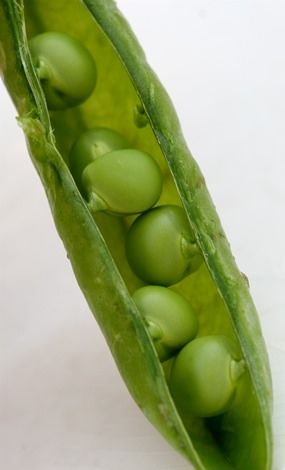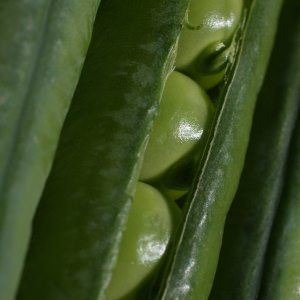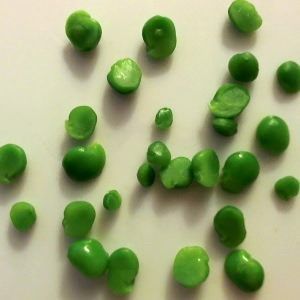
Goldfish need vegetables in their diet.
Without the leafy greens they crave, goldfish can develop nutritional deficiencies down the road. If you continued to give your goldfish just protein snacks, they’d become sick and lethargic, even flipping upside down.
Fancy goldfish especially are known for their swimming problems.
These fish have bulky bodies and tightly packed organs. Because of the distorted arrangement of their swim bladder and digestive tract, fancy goldfish aren’t strangers to constipation. If you have a floating-sensitive fish, your goldfish would appreciate more fiber, pre-soaked dry pellets, and a varied diet.
What better way to give your fish the nutrients they need than by feeding goldfish peas?
Why Feed Green Peas to Goldfish?
Two reasons.
- Unlike this vegetable, green peas sink when placed under water. Sinking goldfish food is especially important for sensitive fish because they won’t have to search for food at the water surface… and suck in air bubbles while they’re at it.
- Green peas are especially rich in fiber. According to this article, one cup of peas contains 7 grams of dietary fiber. That’s more than broccoli (2.4 grams), lettuce (1 gram), and spinach (0.7 of a gram) combined.
Fiber helps goldfish prevent constipation (and other known symptoms of swim bladder problems).
You might feed your goldfish a stable diet of dry and freeze-dried food, but without fiber from fresh vegetables, your goldfish might develop a blockage in the digestive tract. This blockage can cause your goldfish to lose equilibrium, have difficulty swimming, and even swim upside down!
Prevent Constipation By Feeding Goldfish Peas
Many goldfish hobbyists believe that green peas help push trapped air and food blockages from the digestive tract.

The fact remains that without enough fiber, your goldfish will not be able to release waste after a feeding. This waste buildup can cause serious harm.
Goldfish are ravenous eaters and often poop out buckets. Without enough fiber to help bowel movements along, waste that your goldfish are constantly developing will get stuck and put pressure on the swim bladder (source). This pressure will prevent the swim bladder from inflating and deflating as it should. This causes goldfish to swim erratically.
Fancy goldfish with egg-shaped bodies are especially sensitive to swim bladder problems because of how their internal organs are positioned in the body. Often these organs are compressed to make up for their round body shape. The slightest blockage can put pressure on the swim bladder and prevent fancy goldfish from swimming properly.
At the same time, too much fiber will prevent your goldfish from absorbing important nutrients into the body (source), so it’s best to find a balance.
Fresh peas are very high in fiber, so they’re particularly effective for treating constipation (over other vegetables).
Feeding goldfish peas occasionally can prevent constipation, but don’t overdo it. We’ll talk about how many peas to feed (and when) later in this article.
While fresh peas can solve some floating problems, feeding goldfish peas won’t heal genetic swim bladder disease or permanently damaged swim bladders. Peas also won’t cure bacterial infections that may cause swim bladder problems. Feeding goldfish peas will only treat floating problems related to constipation.
Feeding Peas to Goldfish: A Step-By-Step Guide
Constipation can easily be prevented with a quality nutritional diet.
In this section we’ll take a look at how many peas to feed and how to prepare fresh peas before feeding time, including a step-by-step guide on feeding goldfish peas.
How Many Peas and How Often to Feed?
You know what they say…
A green pea a day week keeps the doctor away.
Green peas work great as a preventative against constipation, treatment for constipation, or nutritious snack. But you don’t want to go overboard. Too many peas will prevent your goldfish from absorbing some important nutrients they need to stay healthy.
If you’re…
- Treating constipation: Feed your goldfish a sole diet of peas daily for 3 days. If your fish are still constipated, you can continue feeding goldfish peas for 2 more days. If peas don’t solve the problem after 5 days, it’s likely that your goldfish aren’t constipated (and are suffering from poor water quality, a bacterial infection, internal parasites, or permanent swim bladder damage). When feeding goldfish peas, only feed 2-3 peas per goldfish. Young goldfish can receive half this amount. After treatment, resume your goldfish’s regular diet (and go easy on the feeding from now on).
- Preventing constipation: Feed goldfish fresh peas once per week to keep fiber levels up. Also include fresh vegetables twice per week for a well-rounded diet. Vegetables should be fed to supplement your goldfish’s stable diet of dry food. Fancy goldfish sensitive to swim bladder problems may also benefit from one day of fasting every week. Feed 2-3 peas per adult goldfish. Half this amount for younger goldfish.
As with any food you give your goldfish, too much of a good nutrient can be harmful. Striking a balance is key for long-lasting goldfish that thrive.
But don’t worry. If you follow the recommendations in this guide, you shouldn’t run into problems.
Let’s walk through the steps.
Step 1: Buy Fresh Peas from the Store
There are several varieties of peas you can feed to your goldfish. Each kind has its own nutritional value.

- Garden peas – Garden peas are the most common variety found in stores. They may need to be chopped up for younger goldfish to consume.
- Snow peas – Snow peas are also called sugar peas and are very sweet. They’re pretty small, so it’s a lot easier to break them into bite-sized chunks.
- Snap peas – Snap peas are also sweet, though they’re about the size of garden peas. Snap peas may need to be chopped before feeding.
- Frozen peas – Frozen peas are a great alternative to fresh vegetables. You’ll need to thaw them out or run them under hot water though.
- Split peas – Split peas are bought dried, peeled, and split into two halves. While split peas need to be soaked in hot water (step 2), you can skip step 3 and step 4 in this guide.
- Canned peas – Canned vegetables are very high in sodium. Unless you buy all natural canned peas without added preservatives, I wouldn’t recommend them.
Goldfish aren’t fussy. They could care less what kind of peas you give them. You don’t even have to buy them organic.
Don’t buy seasoned peas for your goldfish though. Spices will make your goldfish sick and could cause serious harm.
My personal favorite is frozen peas. They’re easy to keep, easy to prepare, and can stay in your freezer for several years.
Step 2: Soften Green Peas for Consumption
Before feeding goldfish peas, remove peas from the pod if you bought them attached.
Now let’s prepare the meal.
You can soften peas one of three ways.

- Rinse your peas off with warm water. This method works great for frozen peas. Simply rinse frozen peas off with warm water for 15 – 30 seconds. This will soften them just enough for your goldfish. You can then let the peas defrost on a plate or napkin (if you need more time) before commencing to step 3.
- Place fresh peas into the microwave. This is the fastest method to soften fresh peas. Take a microwave-safe bowl and fill it partly with water. Plop in the peas and microwave them on high for 30 – 60 seconds. Take the bowl out and place the peas on a plate to cool off. Wait a couple minutes, then move to step 3.
- Boil fresh peas on the stove top. This method may take longer but is the most effective. Fill a pot partly with water and let the water come to a boil. Drop fresh peas into the pot and reduce heat. Boil the peas for 1 minute before pouring them into a strainer to cool off. Alternatively, you can replace the hot water with cold water instead of using a strainer. Let the peas cool for a couple minutes before moving to step 3.
The trick here is not to soften the peas so much that they’re mushy but just enough so that your goldfish can digest them easily.
If softened just right, the peas should not cloud the water during feeding time.
Step 3: Remove the Skin before Feeding Goldfish Peas

The thin skin around green peas can make your goldfish choke. That is, if it doesn’t get stuck on the roof of the mouth first.
Remove the skin by either…
- Tearing off the skin: With your fingers, tear a small hole into the skin. This hole can then be used to peel off the remaining skin from the pea. Do this for every pea you plan to feed your goldfish. Discard the skin.
- Squeezing the skin: Pinch a corner of the skin and the weight of the pea should help it slide out smoothly. Be careful though; if the insides are too soft, your peas might turn to mush. Complete this process for each pea, then throw away the skin.
I personally like poking a small hole into the skin and then carefully unwrapping the skin from the vegetable. The pea will keep its shape this way. Then you can cut each pea into equal sections (step 4).
Step 4: Cut Fresh Peas into Two Halves

When you remove the skin from green peas, usually each pea will already be divided into two parts with (what would be) the stem of the seed curved along the center. Cut along this line so that each pea is separated into two halves.
You can now feed your goldfish immediately or make the food even easier to eat in step 5.
Sure, you can squish together both halves of the pea to condense it and make it smaller for feeding. But I find the process of feeding goldfish peas to be a lot cleaner if you instead take the time to cut each pea into bite-sized chunks.
Some fish enthusiasts like feeding goldfish peas the second the peas are removed from the skin. However, your goldfish might have a better time enjoying the meal if you cut them up first. Your goldfish will be able to eat fresh peas quickly and the food won’t hang from their mouths while they munch.
Step 5: Slice Each Pea into Smaller Chunks

Do this especially for young goldfish that can’t fit a whole half of a pea in their mouths.
Cut every chunk (that you created in step 4) in half. Each pea should now be separated into 4 small chunks – a nice size to be easily digested.
I find that goldfish are able to eat these smaller chunks more easily than a whole pea. You can even further slice up each pea for smaller fish, though it may not be necessary.
Now you’re ready to feed the newly prepared meal to your goldfish!
Open the aquarium cover and sprinkle in a few chunks at a time. You should only feed 2 – 3 peas per adult goldfish (1 – 2 peas for younger fish).
An hour after feeding goldfish peas, check the substrate for uneaten food and remove them from the gravel (either with a siphon during a water change or a net).
Put leftover peas you didn’t feed into the freezer. You can defrost them and feed them to your goldfish next time.
Your Goldfish Aren’t Eating Peas?
Peas quickly sink to the substrate. If your goldfish have buoyancy problems, they likely won’t be able to get to the peas for feeding.
You can solve this problem by gently holding your goldfish and hand feeding.
Or, you can pick up a few clean toothpicks and push the opposite end of the pick through a whole pea or half a pea. Then hold the toothpick near your goldfish’s mouth for easy access. Make sure you don’t feed your goldfish with the sharp end – you don’t want to accidentally hurt your fish!
Live, frozen, or freeze-dried daphnia can be fed to your goldfish instead to treat constipation if you have daphnia on hand.
Remember: fiber-rich foods are only solutions for goldfish suffering from constipation. Damaged swim bladders are permanent (there isn’t a cure). Floating problems caused by bacteria, internal parasites, or poor water quality require their own special treatments (and can’t be treated by feeding goldfish peas).
Are You Feeding Goldfish Peas?
What types of peas do you feed? How do you prepare your peas for feeding? What other steps do you take before feeding goldfish peas? Have peas worked for you in the past?
What tricks do you use to cure constipation?
Share your experiences. Post tips or feedback in the comments below!

39 comments
Bravo! You really thought this question through. You might want to post an article about feeding banana slices to GF. I give a few thin (1/8″) ripe banana slices to my four med. fancies about every other day. They nibble the edges, keep on nibbling and pretty soon there’s nothing left… but big grins (or so I imagine) on their faces. They’re fond of corn niblets too, and peas. I always choose organic to reduce possible exposure to nasty chemicals. Steamed carrots can be cut into tiny cubes and fed. These foods all sink, which helps stop GF from gulping air at the surface while they feed. Anyway, thanks again for an excellent li’l article!
Thanks, Chris! I’m happy that you enjoyed this article.
I’ll definitely post a guide on how to feed banana slices in the near future! My goldfish also love them, almost as much as fresh peas! I often like to stick lettuce on the sides of the glass with a veggie clip – it’s really entertaining to watch them tear at it. Though, I often have to remove the leftover lettuce after a couple hours (since the lettuce will sometimes escape their mouths and float around the surface!).
I try to stick with sinking foods as well to prevent buoyancy problems for my fancies. Glad your goldfish enjoy the fruit/vegetable combo!
I have a pond outside with 22 goldfish , all different sizes . How much and how often should I feed them ? Worried that the smaller fish may not get as much as the big guys . This article has opened my eyes to a whole new diet for my goldfish , never heard of giving theme fresh fruit & veggies . Can one goldfish eat too much fresh veggies or do they know when to stop ?
So regular daily food should def not be flakes but what about pellets? I can soak them so they will sink. Is that the proper way to feed them and give them the fruit and veggie combo often? But how often is safe to give them peas and bananas? Thank you so much for posting this article
Hi my gold fish love banana and peas. I didn’t know until I read this. Thanks
Excellent advise guys, I was actually searching the web for something better to feed my goldfish during winter months.
My pond is about 2500L and started off with 2 commets, I have about 40 happy fish in there now, about 15cm long and as fat as pigs. all babies from the original 2.
I have never fed them any vegies before, and cant wait to treat them in the morning.
I have a biological filter filled with plant as well as water lilies in the pond itself.
And haven’t had a days problems with my fish, except for one thing. for some reason they all come to the surface during mid day and gulp air for an hour. then they carry on normally again, is this a sign for lack of oxygen? even though I have 2 waterfalls and many plants in my pond.
Thanx Renier, south africa
Are you mean feed goldfish 2-3 peas per a day. Or 2-3 peas two time a day? I’m little confuse.
I had researched the reason fish get stuck at the top. I think I really stressed my fish moving it from a 2 gallon bowl to a 20 gallon tank. Then I bought it a buddy which promptly attacked it. I ended up putting it in a 5 gallon tank with an air stone. It was doing very poorly, floating upside down and not able to descend. I read about giving it peas which seemed pretty useless as it couldn’t get down. Your suggestion of the toothpick was fantastic. Not sure why it didn’t occur to me. It worked a treat. It seems to be doing much better. Not sure if I dare put the two back together again though.
Thanks – I followed your instruction and my gold fish is no longer swimming belly up.
thank you so much for sharing this with us I hope feeding peas to my fish will make them survuve longer thank you so much.
i like fishies
i fed my fishy two peas
im hoping it’s okay now
Thanks for your great advice .
it can increase my knowledge about goldfish food.
let me ask you some question ,,
which type of diet i can follow for my shubham king fish?
Hi – How many times a day do I give them peas in the 5 day programme? Is it once a day or breakfast, lunch and dinner? Thanks!!
My 2-year-old Oranda was really in trouble – lying on its side at the surface of the pond, gasping. It couldn’t swim properly and wasn’t eating. The other fish were already starting to ‘chew’ its scales off. I isolated it in a tank indoors with filter/aerator and have been feeding peas only for 3 days. Yesterday there was the first sign of poop in the tank. It wasn’t very much and was white at one end, becoming light green. However, 24 hours have gone by with no more sign of poop. Should I add Epsom Salts to the water? The fish is now swimming upright and is looking very much better.
I tried hand feeding my goldfish but he just will not eat the peas. I’m worried about him, is there any other way I can entice him to eat? He’s body has been in a arch shape for about two days and he hasn’t really tried to move in about 12 hours. Is he going to die?
Any suggestions you have would be greatly appreciated. Thank you! xx
I feel very fortunate to have found you. My gold fish is doing so much better. Also liked the comment from the person concerning veggies he feeds his fish. Have not found greens that the fish are intered in yet. Thanks again.
I’m so happy your goldfish are feeling better, Rita!
Carrots and broccoli are a good source of fiber too, though those veggies may not have quite as much fiber as fresh peas! And if you’re interesting in providing a bit more variety on a weekly basis, you can also try feeding romaine lettuce, cauliflower, cucumber, zucchini – even chopped fruit every now and then like grapes and orange slices. But be careful with fruit! You’ll want to feed these once or twice a month as a special treat, since they have high sugar content.
Thank you for this interesting article Christina…I feel like I should have figured this out on my own but I found the tip on peeling the skin off to be very useful lol. I was struggling before this to cut them up. Peeling the skin and cutting the halves is a very easy process. Personally, I like to just let the pea stick to my finger and have the fish take it right from there when possible. Thank you for also publishing the fact that we can feed peas too often, as I was feeding every second day instead of once per week. A couple of personal observations: It seems that when I feed vegetables to my fish it triggers their foraging instincts afterwards and I see them foraging among the gravel much more actively. Also, for my medium sized goldfish, 1 pea had them seemingly full. So far I like this website and its clean look and useful content. Thanks and take care.
That’s great, Freddy! Many people don’t realize that the skin on vegetables can be a choking hazard for goldfish, so they skip that vital step. Glad you’re taking every precaution! And as you mentioned, peeling off the skin first makes cutting fresh peas much easier. 🙂
That’s a great feeding method you got there – letting your goldfish eat the peas from your fingers. I’m sure that’s a good way to build a bond with your fish too, once they get used to swimming so close to your hand. You have to be careful not to get any soap or grease residue from your skin into the aquarium though.
But that’s an interesting find! I love watching goldfish behavior – they’re always so fascinating, the things they get up to!
I am really impressed with the replies you give! I thought you gave up on the site and then boom you are replying a lot and very thoughtful and thorough replies at that. It is nice to see!
Thanks, Freddy! I’ve been going through some things in life, so responses have been a bit slow lately. I am working on a few more articles, so hopefully I can get a routine schedule going! Thank you so much for all of your support and wonderful replies. 🙂
i just bought a few new goldfish, two of the new guys are looking a bit ill, the first the larger fish with protruding eyes looks like his top fin is broken? he is sitting on the bottom of the tank a lot and at times fly aaround, he was grand for a few days and then began this behaviour, now the other black guy smaller fidh regular eyes is sitting ont the bottom of the tank. they were responding to food but not as much now, what should I do? thanks in advance for your help.
Oh no! So sorry to hear about your fish, Betty! Hopefully by now your goldfish are no longer sick.
If not, how are your water conditions? Sometimes it can be tough to figure out what’s wrong, so it’s best to cover all the bases. If you haven’t done so already, you’ll want to test for ammonia, nitrite, and nitrate to begin with. Testing pH will also be good too, since sometimes pH can crash – and that’s never good for a healthy goldfish.
If you need help with water testing, you can take a look at my water parameter guide here.
Also, are there any visual symptoms or odd behavior (besides the obvious sitting on the bottom)? Sometimes goldfish disease symptoms can be hard to find, especially if they’re microscopic parasites! If you have a magnifying glass handy, that can definitely help. But if not, just observe what’s visible from the naked eye.
I’m hoping your goldfish get better soon!
Thank you! After 1 day of giving my goldfish peas the floating to the top of the tank stopped. Now, instead of feeding flakes I’m going to try sinking pellets along with some scattered veggies throughout the week. Thanks for your help!
That’s awesome, Rose! Glad the peas helped. I’m sure your goldfish will enjoy the sinking pellets too! Fancies are really susceptible to buoyancy problems, so it’s good to play it safe with sinking foods and weekly veggies in the diet. You might even want to soak the pellets in a cup of warm water for a few seconds before feeding, so the pellets don’t expand in your goldfish’s intestines. 🙂